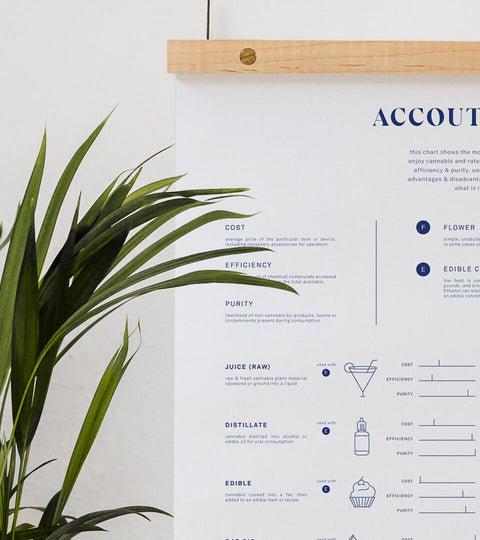Accoutrement: The Many Ways to Enjoy Cannabis
The Goldleaf research team recently completed a new comparison study of sixteen of the most common delivery methods for cannabis. While the field for smoking, dabbing, and vaping accessories continuously widens with new innovations, we focused on the most common and ubiquitous examples for each category. Our goal was to create a chart that shows an overview of the advantages and disadvantages of each option, while also informing those who might be new to the culture of some interesting alternatives.
Tackling this subject wasn't a straight-forward matter. For one, we needed to find a control group so each option would be measured based on the same starting product (cannabis flower, BHO wax, etc.) Because of the countless designs and inventions for each device category (e.g. glass pipe, portable vape) a true apples to apples comparison is incredibly difficult. With this in mind, we based our research on a comparison of specific delivery methods (rather than stand-alone ratings). Our goal, after all, was not to display a universal projection for each camp, rather, to paint a broad stroke of the pluses and minuses of each delivery method to help inform people who might be new to cannabis.
We surveyed a group of 28 participants who utilized the same cannabis control group for all tests. We had them document their findings over the course of two weeks to allow a clean slate for each test. Taking their results, we averaged them to project our data on the "Accoutrement" infographic.
We focused on three points of comparison: price, purity, and efficiency.
Price was based on an average cost to purchase the device and use it. Again, since there is such a wide variety of options (at all different price points), we focused on the best-sellers for the industry and averaged the starting costs of the top three.
Purity is based on the integrity of the smoke, vapor, or edible material. We wanted to compare the likelihood of additional toxins, adulterates, solvents, or other components being present. This presents a challenge because not all flower or concentrates share a common level of purity and much depends on the growing method, harvest-style, and/or method of concentration. Still, using our control group, we could assert some assumptions.
Efficiency is a measure of bang for your buck, or to be more official, the measure of accessible cannabinoids and terpenes from the total available in a specimen (flower, concentrate, or edible). Obviously, a concentrate is going to be more efficient as a whole compared to flower, but how much of that potential is actually accessed? That is the question that guided the data from this field.
View the print in our shop
_
Control Groups
Dry Flower - Gorilla Glue
31.7% THC, 0.5% CBG, 0.1% CBD
2.71% total terpenes, 38.1% total cannabinoids
Concentrate - Gorilla Glue BHO
68.7% THC, .1% CBD, 1.7% CBG, 0.1% CBN
5.45% total terpenes, 70.3% total cannabinoids
Edible - Gorilla Glue Muffin
1oz Gorilla Glue flower per 1 cup butter (following MagicButter recipe)
14.4mg activated cannabinoids per muffin
Labs results provided by Analytical 360
Devices Used
Blunt - Dutch Masters Palma
Joint - Raw Classic Papers
Fruit - Apple
Metal Pipe - Generic Metal Chamber Pipe
Glass Pipe - Classic Spoon Style Glass Pipe
Ceramic Pipe - Stonedware Geopipe
Gandalf Pipe - Wood 14" Gandalf Style Pipe
Water Pipe - Roor Blue 250
Portable Vaporizer - FireFly 2
Pen Vaporizer - Linx Hypnos Zero
Desktop Vaporizer - Volcano Classic
Health Stone - Vaporslide Glass Attachment
Dab Rig - Leisure Glass Recycler
Edible Distillate - made using MagicButter machine
Edible - muffin using butter from MagicButter machine
Raw Juice - whole plant material



